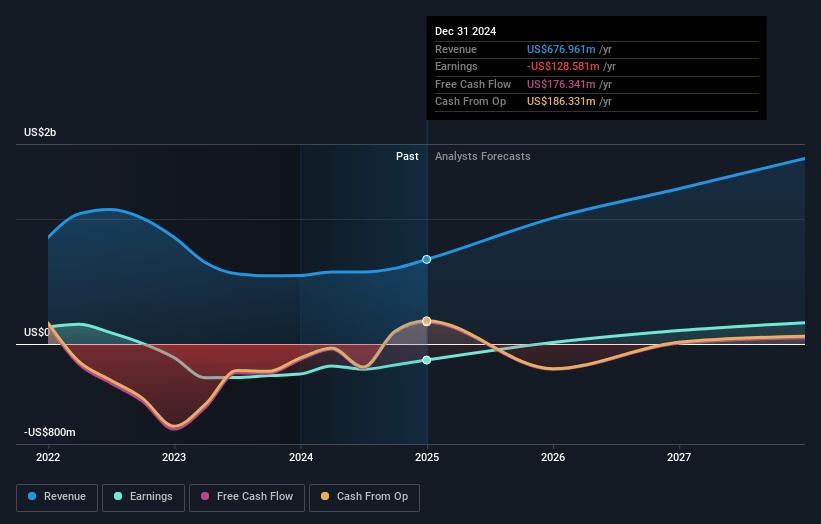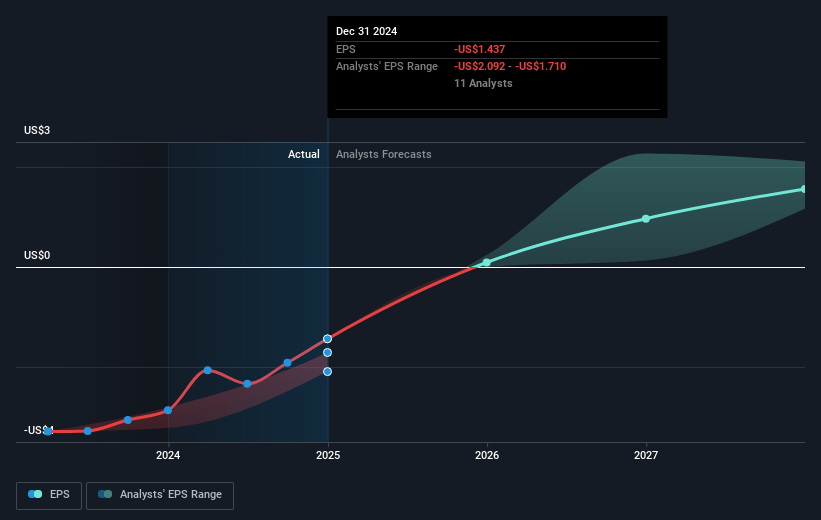Last Update01 May 25Fair value Decreased 0.11%
Key Takeaways
- Improvements in underwriting, automation, and personalization enhance loan approval rates, lower costs, and reduce default risks, positively impacting revenue and net margins.
- Strategic HELOC growth, backed by strong banking relationships, alongside expanded borrower base, sets stage for future revenue growth and earnings support.
- High default rates and macroeconomic volatility threaten revenue stability, while maintaining model accuracy and managing profitability amid these conditions are critical challenges.
Catalysts
About Upstart Holdings- Operates a cloud-based artificial intelligence (AI) lending platform in the United States.
- The implementation of Model 19, featuring the Payment Transition Model (PTM), has improved underwriting accuracy, which is likely to enhance loan approval rates and reduce default risks, positively impacting revenue and net margins.
- Upstart's HELOC product growth, driven by conversion improvements, cross-selling, and state expansion, positions it well for future revenue growth and margins with the potential to leverage its strong relationships with banks and credit unions for cost-effective funding.
- Improvements in small dollar relief loans, such as reduced origination costs, have expanded Upstart's borrower base and are expected to contribute to revenue growth, while the integration of small dollar repayment data will enhance the accuracy of underwriting models.
- Increased automation and personalization in servicing operations have reduced costs and improved borrower outcomes, which will likely improve net margins through operational efficiencies and lower default rates.
- Enhanced lending partner confidence, due to strong platform performance and capital market engagements, strengthens funding capabilities and sets the stage for increased origination volume, supporting earnings growth in the medium term.
Upstart Holdings Future Earnings and Revenue Growth
Assumptions
How have these above catalysts been quantified?- Analysts are assuming Upstart Holdings's revenue will grow by 29.9% annually over the next 3 years.
- Analysts assume that profit margins will increase from -19.0% today to 11.5% in 3 years time.
- Analysts expect earnings to reach $170.7 million (and earnings per share of $1.56) by about May 2028, up from $-128.6 million today. However, there is a considerable amount of disagreement amongst the analysts with the most bullish expecting $226.7 million in earnings, and the most bearish expecting $122.2 million.
- In order for the above numbers to justify the analysts price target, the company would need to trade at a PE ratio of 61.9x on those 2028 earnings, up from -36.4x today. This future PE is greater than the current PE for the US Consumer Finance industry at 10.0x.
- Analysts expect the number of shares outstanding to grow by 6.64% per year for the next 3 years.
- To value all of this in today's terms, we will use a discount rate of 7.5%, as per the Simply Wall St company report.
Upstart Holdings Future Earnings Per Share Growth
Risks
What could happen that would invalidate this narrative?- The company has faced periods of underperformance due to high default rates during macroeconomic volatility, potentially impacting future revenue and profit stability.
- There are concerns about maintaining consistent model accuracy, which is crucial for managing risk and ensuring profitability, due to potential gaps between predicted and actual default rates.
- The company's profitability is sensitive to macroeconomic changes, such as interest rate movements and macro indices (e.g., the Upstart Macro Index), which could affect earnings and net margins if conditions worsen.
- Although the company plans to reduce loans on its balance sheet, potential funding constraints could delay these efforts, affecting liquidity and net income.
- Investments in new product categories and marketing could pressure operating margins and net income if not managed properly against growth expectations.
Valuation
How have all the factors above been brought together to estimate a fair value?- The analysts have a consensus price target of $73.923 for Upstart Holdings based on their expectations of its future earnings growth, profit margins and other risk factors. However, there is a degree of disagreement amongst analysts, with the most bullish reporting a price target of $110.0, and the most bearish reporting a price target of just $15.0.
- In order for you to agree with the analyst's consensus, you'd need to believe that by 2028, revenues will be $1.5 billion, earnings will come to $170.7 million, and it would be trading on a PE ratio of 61.9x, assuming you use a discount rate of 7.5%.
- Given the current share price of $49.19, the analyst price target of $73.92 is 33.5% higher.
- We always encourage you to reach your own conclusions though. So sense check these analyst numbers against your own assumptions and expectations based on your understanding of the business and what you believe is probable.
How well do narratives help inform your perspective?
Disclaimer
AnalystConsensusTarget is a tool utilizing a Large Language Model (LLM) that ingests data on consensus price targets, forecasted revenue and earnings figures, as well as the transcripts of earnings calls to produce qualitative analysis. The narratives produced by AnalystConsensusTarget are general in nature and are based solely on analyst data and publicly-available material published by the respective companies. These scenarios are not indicative of the company's future performance and are exploratory in nature. Simply Wall St has no position in the company(s) mentioned. Simply Wall St may provide the securities issuer or related entities with website advertising services for a fee, on an arm's length basis. These relationships have no impact on the way we conduct our business, the content we host, or how our content is served to users. The price targets and estimates used are consensus data, and do not constitute a recommendation to buy or sell any stock, and they do not take account of your objectives, or your financial situation. Note that AnalystConsensusTarget's analysis may not factor in the latest price-sensitive company announcements or qualitative material.






